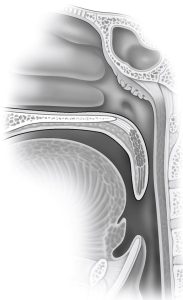The Upper Airway Stimulation system from Inspire Medical Systems has been an important and exciting addition to the array of treatment options for obstructive sleep apnea. I was the first surgeon in the Western US to offer it to patients after FDA approval in 2014, and I have seen the tremendous difference it has made in the lives of many patients.
One of the key tests to determine whether someone is eligible to receive this treatment is the drug-induced sleep endoscopy examination that evaluates the physical causes of a patient’s blockage in breathing. This test was used to determine eligibility for system implantation in the landmark STAR Trial that was published in the New England Journal of Medicine and was the basis for FDA approval. The key finding for eligibility was a pattern of blockage behind the palate called complete concentric collapse. This finding, present in about 30% of otherwise-eligible patients, excludes someone from receiving Inspire therapy.
I have written previously about the fact that drug-induced sleep endoscopy provides much more information than just this specific finding. To investigate whether there was more useful information related to Inspire therapy, we assembled a database involving over 300 individuals from 10 centers around the world. Using a fairly-rigorous scientific approach, we showed that some other drug-induced sleep endoscopy findings are associated with better or poorer outcomes from Inspire therapy:
- complete tongue-related obstruction is associated with better outcomes
- complete collapse of the sides of the throat is associated with poorer outcomes
Suraj Kedarisetty, MD completed his sleep surgery training with me when I was at USC, and he is now the primary sleep surgeon for Kaiser Permanente at their Oakland and Vallejo offices. Dr. Kedarisetty had the idea of testing whether specific findings of awake office endoscopy would further be associated with outcomes, in addition to those from drug-induced sleep endoscopy. Specifically, he was interested in palate shape, as described by Tucker Woodson, MD from the Medical College of Wisconsin. So he reviewed all of the drug-induced sleep endoscopy videos, along with Abhay Sharma, MD (completing his fellowship with Dr. Woodson and now at the University of South Florida) and Emily Commesso, MD (the sleep surgery fellow who trained with me after Dr. Kedarisetty and now back at Duke University).
We all worked together with Dr. Woodson, and the research findings were published this month in the medical journal The Laryngoscope. They showed that outcomes of Inspire Upper Airway Stimulation were poorer with the so-called vertical palate shape or a finding related to that shape. The vertical palate shape is characterized by narrowing of the airway behind the hard palate bone, as shown below with the typical vertical orientation of the soft palate muscle. For example, the vertical palate shape was associated with a lesser response rate (56% vs. 75%), and the specific finding of narrowing behind the hard palate bone was also associated with a lesser response rate (60% vs. 76%). What was even more striking was that the combination of these findings with the unfavorable finding from the previous study (complete collapse of the sides of the throat) was associated with especially poor outcomes (response rate 22% vs. 74%). All of these findings were statistically signficant, before and after use of statistical techniques that adjust for differences among individuals in age, gender, and body mass index.
The bottom line
This research study is directly relevant to taking care of patients. I use the findings from our studies all the time as I evaluate patients and discuss potential outcomes of Inspire Upper Airway Stimulation. What is reassuring is that, based on presentations of this work at our major scienticic meetings, many colleagues have indicated that they, too, use these findings as they care for patients. It is a testament to the commitment of so many people in assembling these large databases involving multiple centers and in conducting high-quality scientific evaluations.




90 − = 87